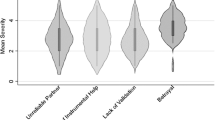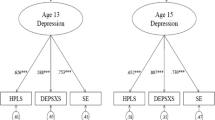Abstract
The present study sought to extend our knowledge of dysphoric adolescents' dyadic peer interactions. Thirty female dyads (ages 13–17) were videotaped interacting during both a structured and an unstructured task. Fourteen of the dyads were each comprised of a dysphoric girl and a nondysphoric girl; the remaining dyads were comprised of two nondysphoric girls. Girls were considered dysphoric if they scored 10 or higher on the Beck Depression Inventory. Dysphoric subjects evaluated their performances more negatively than nondysphoric subjects and rated their partners more negatively overall. The partners of the dysphoric girls were viewed by raters as less positive and less happy. They saw the dysphoric teens as making more critical comments and evaluated them more negatively overall. There was also a tendency for these girls to reject their dysphoric partners and to become more passive during the unstructured task. The findings indicate that dysphoric adolescent girls evoke negative reactions from peers and negatively influence their peers' behavior. These negative reactions from others may lead to further difficulties in negotiating the developmental tasks of adolescence.
Similar content being viewed by others
References
Altmann, E. D., & Gotlib, I. H. (1988). The social behavior of depressed children: An observational study.Journal of Abnormal Child Psychology, 16, 29–44.
American Psychiatric Association. (1987).Diagnostic and statistical manual of mental disorders (3rd ed., rev.). Washington, DC: Author.
Beck, A. T. (1967).Depression: Clinical, experimental, and theoretical aspects. New York: Harper & Row.
Beck, A. T., Ward, C. M., Mendelson, M., Mock, J. E., & Erbaugh, J. K. (1961). An inventory for measuring depression.Archives of General Psychiatry, 4, 561–571.
Connolly, J., Geller, S., Marton, P., & Kutcher, S. (1992). Peer responses to social interaction with depressed adolescents.Journal of Clinical Child Psychology.21, 365–370.
Coyne, J. C. (1976a). Towards an interactional model of depression.Psychiatry, 39, 28–40.
Coyne, J. C. (1976b). Depression and the response of others.Journal of Abnormal Psychology, 85, 186–193.
Dembo, M. H., & McAuliffe, T. J. (1987). Effects of perceived ability and grade status on social interaction and influence in cooperative groups.Journal of Educational Psychology, 79, 415–423.
Erikson, E. H. (1968).Identity: Youth and crisis. New York: Norton.
Gotlib, I. H., & Meltzer, S. J. (1987). Depression and the perception of social skill in dyadic interactions.Cognitive Therapy and Research, 11, 41–54.
Gotlib, I. H., and Robinson, L. A. (1982). Responses to depressed individuals: Discrepancies between self-report and observer-rated behavior.Journal of Abnormal Psychology, 91, 231–240.
Gurtman, M. B. (1986). Depression and the response of others: Re-evaluating the re-evaluation.Journal of Abnormal Psychology, 95, 99–101.
Hammen, C. L., & Peters, S. D. (1978). Interpersonal consequences of depression: Responses to men and women enacting a depressed role.Journal of Abnormal Psychology, 87, 322–332.
Harris, M. J. (1990). Effect of interaction goals on expectancy confirmation in a problem-solving context.Personality and Social Psychology Bulletin, 16, 521–530.
Hollingshead, A. B. (1975).Four factor index of social status. Unpublished manuscript.
Kazdin, A. E., Esveldt-Dawson, K., Sherick, R. B., & Colbus, D. (1985). Assessment of overt behavior and childhood depression among psychiatrically disturbed children.Journal of Consulting and Clinical Psychology, 53, 201–210.
Kendall, P. C., Hollon, S. C., Beck, A. T., Hammen, C. L., & Ingram, R. E. (1987). Issues and recommendations regarding use of the Beck Depression Inventory.Cognitive Therapy and Research, 11, 289–299.
Rosenthal, R., & Rosnow, R. L. (1991).Essentials of behavioral research: Methods and data analysis. New York: McGraw-Hill.
Rudolph, K. D., Hammen, C., & Burge, D. (1994). Interpersonal functioning and depressive symptoms in childhood: Addressing the issues of specificity and comorbidity.Journal of Abnormal Child Psychology, 22, 355–371.
Segrin, C., & Dillard, J. P. (1992). The interactional theory of depression: A meta-analysis of the research literature.Journal of Social and Clinical Psychology, 11, 43–70.
Teri, L. (1982). The use of the Beck Depression Inventory with adolescents.Journal of Abnormal Child Psychology, 10, 277–284.
Zuckerman, M., & Lubin, B. (1965).Manual for the Multiple Affect Adjective Checklist. San Diego: Education and Industrial Testing Service.
Author information
Authors and Affiliations
Rights and permissions
About this article
Cite this article
Baker, M., Milich, R. & Manolis, M.B. Peer interactions of dysphoric adolescents. J Abnorm Child Psychol 24, 241–255 (1996). https://doi.org/10.1007/BF01441630
Received:
Issue Date:
DOI: https://doi.org/10.1007/BF01441630




